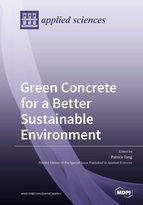Green Concrete for a Better Sustainable Environment
A special issue of Applied Sciences (ISSN 2076-3417). This special issue belongs to the section "Civil Engineering".
Deadline for manuscript submissions: closed (31 March 2020) | Viewed by 27347
Special Issue Editor
Interests: sustainable and low carbon concrete; advanced composite materials; phase change materials; nanomaterials; energy efficient building design; environmental sustainability; waste management
Special Issues, Collections and Topics in MDPI journals
Special Issue Information
Dear Colleagues,
Green concrete is defined as concrete that uses waste material as at least one of its components, or its production process does not lead to environmental destruction, or it has high performance and life cycle sustainability. At present, natural resources are running out. Using industrial and construction waste as raw materials for the production of cement and concrete can be regarded as a valuable resource for civil infrastructure construction. Green concrete will not only contribute to a circular economy but can also help to reduce the amount of embodied energy and CO2 emissions associated with cement manufacturing as well as to mitigate the environmental threats associated with industrial waste materials.
This Special Issue of the journal Applied Sciences on the topic of “Green Concrete for a Better Sustainable Environment” aims to cover recent advances in the development of green concrete solutions and deliberate on what can best be done to leverage the opportunities.
Proposed Topics
The followings is a comprehensive (but not exhaustive) list of topics proposed for this Special Issue:
- Environmentally friendly concrete
- Sustainable concrete
- Recycled concrete
- Industrial wastes utilization
- Construction and demolition waste utilization
- Reusable or recyclable construction materials
- Design for long life and adaptability
A/Prof. Patrick Tang
Guest Editor
Manuscript Submission Information
Manuscripts should be submitted online at www.mdpi.com by registering and logging in to this website. Once you are registered, click here to go to the submission form. Manuscripts can be submitted until the deadline. All submissions that pass pre-check are peer-reviewed. Accepted papers will be published continuously in the journal (as soon as accepted) and will be listed together on the special issue website. Research articles, review articles as well as short communications are invited. For planned papers, a title and short abstract (about 100 words) can be sent to the Editorial Office for announcement on this website.
Submitted manuscripts should not have been published previously, nor be under consideration for publication elsewhere (except conference proceedings papers). All manuscripts are thoroughly refereed through a single-blind peer-review process. A guide for authors and other relevant information for submission of manuscripts is available on the Instructions for Authors page. Applied Sciences is an international peer-reviewed open access semimonthly journal published by MDPI.
Please visit the Instructions for Authors page before submitting a manuscript. The Article Processing Charge (APC) for publication in this open access journal is 2400 CHF (Swiss Francs). Submitted papers should be well formatted and use good English. Authors may use MDPI's English editing service prior to publication or during author revisions.
Keywords
- Green concrete
- Industrial waste
- Construction and demolition waste
- Recycled materials
- Supplementary cementitious materials
- Life-cycle analysis






